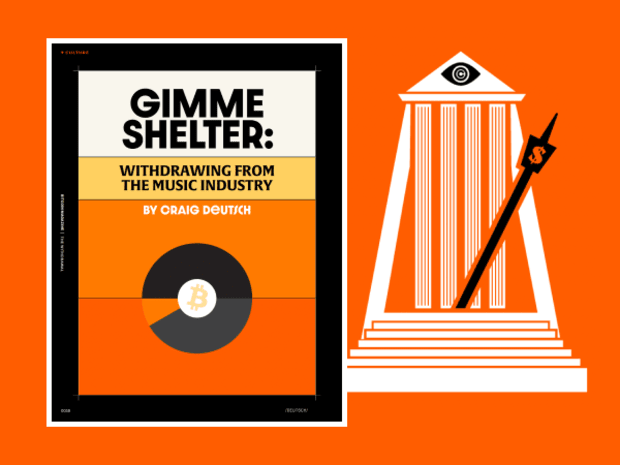This article is featured in Bitcoin Magazine’s “The Withdrawal Issue”. Click here to subscribe now.
A PDF pamphlet of this article is available for download.
Music Industry Misfortune
The music industry is notorious for preying on the artists on which its existence depends. In the early days of recorded music, this exploitation started with unfavorable contracts, depriving musicians of the fruits of their labor while record labels made all the money. The mistreatment has since evolved into the Live Nation Entertainment monopoly, where the company has a nearly exclusive hold on the ticket market (thanks, Ticketmaster!) and an equally tight grasp on the event side, where the company owned at least 259 venues worldwide as of 2021, and where many of their ticketed concerts are held.
Ticketmaster has long faced the ire of musicians and die-hard fans fed up with surreptitious order processing fees. In 1994, Pearl Jam made a complaint to the Justice Department accusing the company of being a monopoly. No action was made at that time, but Ticketmaster faced and lost a similar lawsuit in 2003. The company was ordered to pay $400 million in credits to 50 million ticket buyers. This author was able to cash in about $20 for a single concert, which nearly canceled out the service fees, but didn’t even begin to cover the cost of the ticket.
In more recent news, Swifties sued Ticketmaster and Live Nation when presale tickets to Taylor Swift’s “Eras Tour” sold out instantly. They were listed for thousands of dollars on resale within minutes on the same site the original tickets were sold, prompting a Senate Judiciary hearing in January 2023. Singer and songwriter, Clyde Lawrence, explained how Live Nation Entertainment serves three roles: promoter, venue, and ticketing company. He shared, “Due to Live Nation’s control across the industry, we have practically no say or leverage in discussing these line items, nor are we afforded much transparency surrounding them”. From a ticket with a face value of $42, an artist might end up with only $6 of that sale.
Ultimately, musicians’ challenges with profitably monetizing their work has been a problem since greedy bigwigs realized they could make a buck on the backs of creatives who just wanted to hone their craft and make a respectable living.
In order to bring in money, musicians had to fit the arbitrary mold that record labels made using their industry’s influence and power to shape culture by picking what type of music would get the most airtime and send the media magnates’ message of choice. Read: “The Secret Meeting that Changed Rap Music and Destroyed a Generation”.
While artists often just want to write music and spread their tunes to as many people as possible, records, 8-tracks, cassettes, and CDs are only the tip of the iceberg of financial success. Over time, artists have had to rely more and more on touring to promote an album, sell merchandise, and make money through ticket sales. As mentioned above, ticket sales are no longer a viable source of revenue (though perhaps they never were), and record label contracts haven’t ever been a favorable agreement.
The earlier problems of the music industry are still prevalent, though less so from legacy record labels and more so from the centralization of the live music industry, exacerbated with the digitization of music through streaming platforms. In the case of Spotify, what artists receive per stream is between $0.003 to $0.005. On average, TIDAL pays out around $0.013 per stream. Music streaming platforms are not the only platforms at fault. According to Google Play Music data, music content on YouTube gets $0.00676 per stream on average.
These are not exactly eye-popping numbers and make it difficult for all but the most famous artists to earn a living. A musician who is able to get one million streams makes $5,000 from Spotify, assuming they meet the requirements for the higher-end payscale. Barely enough for a month’s rent and food. And that doesn’t consider the bands who split their profits among multiple members, writers, and producers.
But thanks to the advent of an internet-native currency, there is a brand new opportunity to completely reinvent the structure of the music industry, pairing bitcoin with digitized music.
Value-4-Value
The value-for-value model is a game-changer to monetizing creative works in a world of infinite content. It provides the viewer with the completely voluntary ability to give any amount of money directly to a content creator. With the use of the Lightning Network, micropayments of bitcoin can be sent immediately and effortlessly.
This model is different from the subscription-based structure where users have to put in a credit card and be charged on a monthly or annual basis in order to access the entire body of work across a certain publication, platform, or creator.
The story is likely familiar. You see a captivating headline for an article you’re interested in reading, but when you click the link, you need to sign up and pay for a monthly subscription in order to get past the first paragraph. Chances are you left the page without reading, but what if you could’ve accessed it with a $0.10 instantaneous payment just by scanning a QR code?
Micropayments are simply impossible with the legacy financial system. PayPal takes a fixed $0.49 fee plus a 3.49% fee of the total transaction, so it’s preposterous to attempt a $0.10 donation to creators in that way. Ignoring credit card minimums, processing fees are usually around 3%, so if you tried tipping $0.10, the artist would only be left with $0.07. The Lightning Network creates the potential for bitcoin micropayments, but this description isn’t quite aligned with the value-for-value model.
In essence, a value-for-value pay structure puts the onus of support on the person engaging with the content. The person reading, listening, watching, or using the content can make a choice to pay as much or as little as they deem appropriate. Most users won’t pay anything. Some will pay a little and some will pay a lot. This type of monetization structure has been taking off with podcasts on podcasting 2.0 apps like Fountain, which allows podcasters to receive payment directly from users who choose to send them small amounts of bitcoin on a minute-by-minute basis from their own wallet. Similarly, the Nostr (“notes and other stuff transmitted by relays”) social media protocol allows users to connect a Lightning wallet and receive “zaps” for popular posts.

Now, this idea is starting to make waves in the music streaming world as well. Wavlake was created in order to develop and push forward the standards already being used in the podcasting 2.0 model. Sam Means and Michael Rhee designed Wavlake to give musicians an opportunity to directly monetize their work in a value-for-value economy. Musicians can upload music to the platform and instantly receive direct bitcoin payments from listeners and fans. Listeners can “boost” songs by setting a rate and sending bitcoin to artists as they listen and enjoy certain sections of music that resonate with them.
According to its founders, the idea of Wavlake is to “rethink how the music business works globally and start fresh”. Their main goal is to fix the music business to put artists in charge. They think that artists should be the ones that make the money off their music and not have to do extra things just to survive.
Joe Martin is one musician that sees the value in this new type of streaming service that directly supports musicians. “These platforms are building the tools for content creators to take back control of their work in a new and unique way”, he said.
Bitcoin opens the door for micropayments, which in turn, creates new circumstances for people to send value over the internet, removing the friction of geographical borders with different local currencies. Or as Martin put it, “The coolest thing about this, apart from the no-minimum amount, is that anyone around the world with an internet connected device could have sent me value, instantly, at no cost and with final settlement”.
Musicians finally have the tools to fully own the fruits of their labor. Bitcoin equips those who use it with full sovereignty over their finances and artists are no exception. Thanks to bitcoin micropayments over the Lightning Network and a new vision for supporting creators, a direct relationship between artists, their work, and their fans is finally available to us.
Not only can fans send value directly to their favorite artists, but they can also include comments with their donations, and other fans can participate by sending value and replies to commenters. Through this system, new types of borderless communities can form around the arts.
We haven’t even begun to scratch the surface of the full range of uses and benefits of the value-for-value model in general, let alone in the music industry. When artists and fans have a direct relationship with one another, there are countless and currently unimaginable trajectories of mutual benefit for both creators and listeners. With the breakthrough of a borderless, internet-native digital currency that runs on communication networks, the possibilities are as endless as the human imagination’s desire to be heard and understood. Musicians and music lovers everywhere can finally break free from the clutches of the exploitative industry and build a new, alternative system that truly serves creators and their fans.
This article is featured in Bitcoin Magazine’s “The Withdrawal Issue”. Click here to subscribe now.
A PDF pamphlet of this article is available for download.
